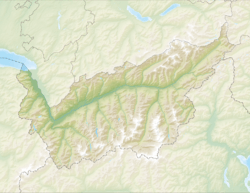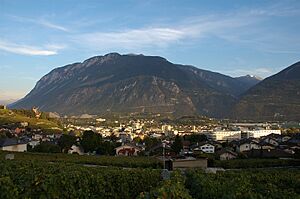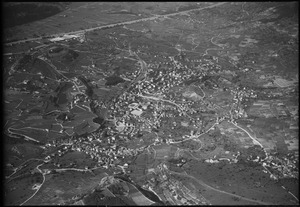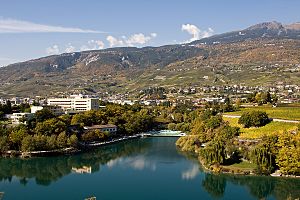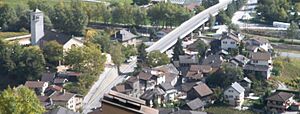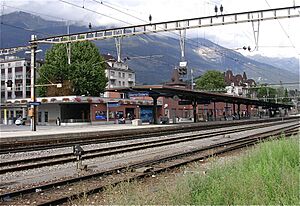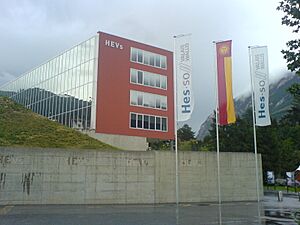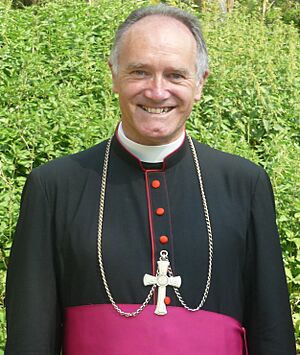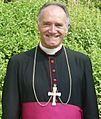Sierre facts for kids
Quick facts for kids
Sierre
|
||
|---|---|---|
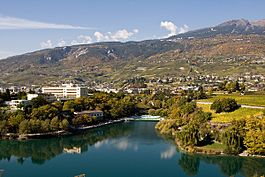 |
||
|
||
| Country | Switzerland | |
| Canton | Valais | |
| District | Sierre | |
| Area | ||
| • Total | 19.13 km2 (7.39 sq mi) | |
| Elevation | 533 m (1,749 ft) | |
| Population
(Dec 2020 )
|
||
| • Total | 16,819 | |
| • Density | 879.19/km2 (2,277.1/sq mi) | |
| Postal code |
3960
|
|
| Surrounded by | Chalais, Anniviers, Chermignon, Chippis, Grône, Lens, Montana, Randogne, Saint-Léonard, Salgesch, Venthône, Veyras | |
| Twin towns | ||
Sierre (pronounced "see-air") is a city in Switzerland. It is the main town of the Sierre district in the Valais area. About 16,332 people live there.
Sierre is often called the "City of the Sun." This is because it gets around 300 sunny days each year! It is the last city in Valais where French is the main language. Just a few kilometers away, the canton switches to German. About 8% of the people in Sierre speak German.
A Look at Sierre's Past
Sierre was first mentioned around the year 800. Back then, it was called Sidrium. Some old papers from the 1100s say the village started in 515. Later, it was known as Sirro in 1179 and Syder in 1393.
How Did Sierre Begin?
The area around Sierre was settled a very long time ago. People lived on Gerunden hill even before recorded history. Archaeologists have found many old items there. These include stone tools from the Stone Age. They also found weapons and jewelry from the Bronze Age. Objects from the early Iron Age were discovered too. Even Roman coins and pottery have been found.
During the Roman times, Sierre wasn't a big city. Instead, there were several groups of fancy homes. Remains of Roman houses have been found under the Saint-Ginier chapel. Other Roman ruins are near the Château de Villa.
Sierre in Medieval Times
In 515, the land of Sierre was given to the Abbey of Saint-Maurice. By the 1000s, the Bishop of Sion owned Sierre. Important families and residents lived on three hills: Gerunden, Vieux-Sierre, and Plantzette. Each hill had a castle. These castles were homes for the Bishop's helpers. They also offered safety for the people.
In the mid-1300s, these castles were destroyed. This happened during a war between the Bishop and other powerful families. The people then moved north to a flatter area called Plan-Sierre. Only Goubing Castle, southeast of Sierre, survived.
How Sierre Became a City
The people of Sierre formed a group to manage their shared lands. They met twice a year to decide on land use and local rules. In the 1300s and 1400s, this group became more political. They started handling daily village matters. They even gained the right to choose their own judges. This group grew into the "Noble Contrée." This was the start of the Sierre region.
The town of Plan-Sierre soon became the leader of the Noble Contrée. In 1559, Plan-Sierre was divided into four parts. In 1620, the town hall was built.
Sierre in the 1800s
Sierre was the capital of its region. It fought against the French when they invaded Switzerland in 1798–99. In 1799, French soldiers took over the city. Sierre became their main base.
Later, Sierre was the seat of government in 1839–40. This was during conflicts between different parts of Valais. After 1848, the villages around Sierre became official towns. The Sierre region became the District of Sierre, with Sierre as its capital.
Sierre in Modern Times
At the start of the 1900s, Sierre became important for its economy. It was a good place for making aluminium. This is because the area has access to hydroelectricity, which is power from water. Today, aluminium companies still employ many people in Sierre and nearby Chippis.
In 2007, Sierre joined with Crans-Montana. They formed a group to solve common problems. This was especially helpful for tourism and transportation.
Where is Sierre Located?
Sierre covers an area of about 19.2 square kilometers (7.4 square miles). A large part of this land is used for farming (34.5%). Forests cover about 21.4% of the area. Buildings and roads make up 34.4%.
Sierre is in the middle of the Rhône valley. It sits on the right side of the river. A nearby mountain stream, Raspille, is seen as the line between French and German-speaking Switzerland.
The city of Sierre includes several villages. These are Granges, Noës, and Muraz. It also has smaller settlements like Gerunden and Glarey.
Sierre is a great starting point for visiting nearby tourist spots. These include the villages of Vercorin and Crans-Montana. You can reach Crans-Montana by a special funicular railway. There is also a small lake called Lac de Géronde on the edge of the city.
Sierre's Coat of Arms
The official symbol of Sierre is a red shield with a golden sun. The sun is shining brightly. This symbol was shown on an old map printed in 1545.
Who Lives in Sierre?
Sierre has a population of about 16,332 people. About 27% of the people living in Sierre are from other countries. Over the past ten years (2000–2010), the population grew by about 12.3%.
Most people in Sierre speak French (about 74.8%). German is the second most common language (12.6%). Italian is spoken by about 5.3% of the people.
In 2008, about 48.4% of the population was male and 51.6% was female. Many people (about 37.5%) were born in Sierre. Others were born in the same canton (25.9%) or other parts of Switzerland (9.9%). About 22.9% of the people were born outside Switzerland.
In 2000, children and teenagers (0–19 years old) made up 22% of the population. Adults (20–64 years old) were 61.9%. Seniors (over 64 years old) were 16.1%.
The chart below shows how Sierre's population has grown over time:

Important Buildings and Places
The Alusuisse company's power station and buildings are very important. They are listed as a Swiss heritage site. The whole town of Sierre is part of the Inventory of Swiss Heritage Sites.
What to See in Sierre
Sierre has a local wine museum. It is called the Musée Valaisan de la Vigne et du Vin. There is also a museum about the poet Rainer Maria Rilke. He lived in Sierre until he passed away. He is buried in the nearby town of Raron.
Sister Cities Around the World
Sierre is connected to several cities in other countries. These are called "twin towns" or "sister cities." They work together on cultural and other projects.
|
|
|
Sierre's Economy and Jobs
In 2010, the unemployment rate in Sierre was 5%. Many people work in different types of jobs.
- Primary sector: This includes jobs like farming and forestry. About 195 people worked in this area.
- Secondary sector: This includes jobs in factories and construction. About 2,654 people worked here. A large number (71.4%) were in manufacturing.
- Tertiary sector: This includes jobs in services. About 6,607 people worked in this area. Many worked in sales, transportation, hotels, or restaurants. Others worked in healthcare or education.
Sierre has a long history of making wine. It is home to a special grape called Rèze. This grape is used to make a unique Swiss wine called Vin des glaciers.
Religion in Sierre
Based on the 2000 census:
- Most people (77.8%) were Roman Catholic.
- About 5% belonged to the Swiss Reformed Church.
- Other Christian churches, Orthodox churches, and other religions were also present.
- About 4.44% of the population did not belong to any church.
Weather in Sierre
Sierre gets rain or snow about 87.2 days each year. On average, it receives about 657 millimeters (25.9 inches) of rain or snow.
- The wettest month is December. It gets about 72 millimeters (2.8 inches) of rain or snow.
- August has the most days with rain or snow (8.4 days).
- September is the driest month. It gets about 37 millimeters (1.5 inches) of rain or snow.
Learning and Schools
Many people in Sierre have finished their education. About 32.2% have completed high school. About 11% have gone on to higher education, like university.
In the 2010–2011 school year, Sierre had 149 students in its school system.
- Young children can attend one year of non-required Kindergarten. There were 31 kindergarten students.
- Primary school lasts for six years. Sierre had 149 students in primary school.
- Older students attend secondary school in a nearby town.
Sierre also has a library called the Bibliothèque et Médiathèque Sierre. In 2008, it had over 65,000 books and other media. It loaned out over 92,000 items that year.
Sports in Sierre
The local ice hockey team is called HC Sierre. They play in the Swiss League, which is the second-highest level of Swiss ice hockey. Their home games are played at the Graben Arena, which can hold 4,500 fans.
Fun Events in Sierre
Sierre hosts several exciting events throughout the year:
- DreamAgo Screenwriting Workshop: In early May, there is a free week of film showings at the Cinéma du Bourg.
- Festival Week-end au bord de l'eau: This music festival happens in late June or early July.
- Sierre Blues Festival: A blues music festival takes place in August.
Famous People from Sierre
Many interesting people have connections to Sierre:
- Princess Henriette of Belgium (1870–1948): A sportswoman known for her shooting skills. She passed away in Sierre.
- Rudolf Kassner (1873–1959): An Austrian writer and philosopher who passed away in Sierre.
- Edmond Bille (1878–1959): A painter, engraver, and politician who passed away in Sierre.
- Jean Daetwyler (1907–1994): A composer famous for his Alphorn music. He passed away in Sierre.
- S. Corinna Bille (1912–1979): A French-speaking writer who grew up and passed away in Sierre.
- Bernard Fellay (born 1958): A Swiss Roman Catholic bishop.
- Claude Barras (born 1973): A Swiss film director.
- Vincent Gessler (born 1976): A Swiss science fiction author.
Sports Stars from Sierre
- Jacques Plante (1929–1986): A famous Canadian hockey player. He was the first goalie to wear a mask in the NHL. He is buried in Sierre.
- Alexandre Moos (born 1972): A professional Swiss mountain biker.
- Stephane Grichting (born 1979): A retired footballer who played for Switzerland.
- Johann Tschopp (born 1982): A professional Swiss mountain bike racer.
Images for kids
See also
 In Spanish: Sierre para niños
In Spanish: Sierre para niños




